This article was published in Scientific American’s former blog network and reflects the views of the author, not necessarily those of Scientific American
I’m a huge fan of herons. I think they’re among the most awesome and charismatic of birds, and also among the most fascinating in terms of what they get up to behaviourally. Their anatomy and ecology are interesting too. Today I want to say a few things about one heron in particular: the Great blue heron Ardea herodias of North America, the Caribbean, the Galapagos and northern South America. This article appears thanks to encouragement from Kevin Gibbs.
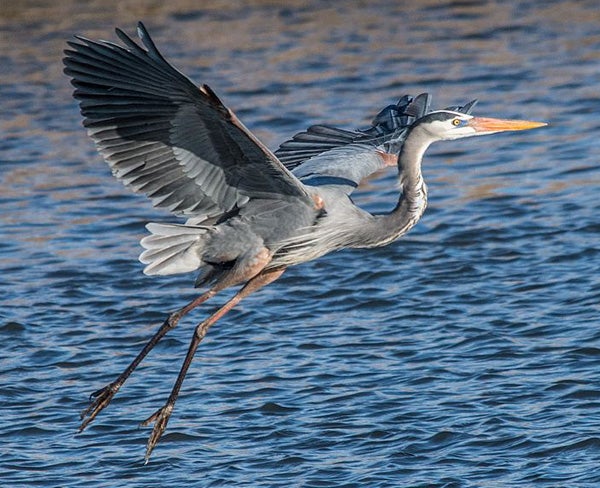
Great blue heron in flight in Delaware. Credit: Steven Fine Wikimedia (CC BY-SA 4.0)
The Great blue heron is a sizeable bird, in cases exceeding 1.3 m in length, 1.3 m in standing height, and 2.1 m in wingspan. Typical birds (not the white ones, on which read on) are generally blue-grey, tinged with violet, on the neck, back, sides and belly. They have chestnut leg feathers (Hancock & Kushlan 1984). The bill is mostly yellow and plumes grow from the back and lower neck during the breeding season. The iris reddens during the breeding season, and the legs turn pinkish-orange too. Males are larger than females, as is typical for herons.
On supporting science journalism
If you're enjoying this article, consider supporting our award-winning journalism by subscribing. By purchasing a subscription you are helping to ensure the future of impactful stories about the discoveries and ideas shaping our world today.
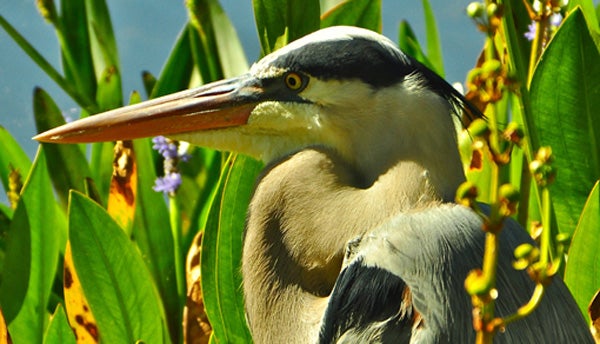
Great blue heron in splendid profile. The lores (that bare area in front of the eyes) changes colour during the breeding season too, from yellowish to green or blue. Credit: Kozarluha Wikimedia (CC BY-SA 3.0)
The Great blue heron is very obviously a close relative of the other Ardea herons, in particular the Afro-Eurasian Grey heron A. cinerea and the South American Cocoi or White-necked heron A. cocoi (McCracken & Sheldon 1998). All three are regarded as members of the same ‘superspecies’ by some authors. There’s a bunch of other Ardea species, but I have to ignore them here. Beyond this, Ardea is most closely related to Casmerodius and Bubulcus (Sheldon et al. 2000).
What is the Great white heron? The Great blue heron is not just bluey-grey – it also seemingly occurs in a snow-white form, this long being regarded as a separate species called the Great white heron A. occidentalis. Here we come to an area of some disagreement.
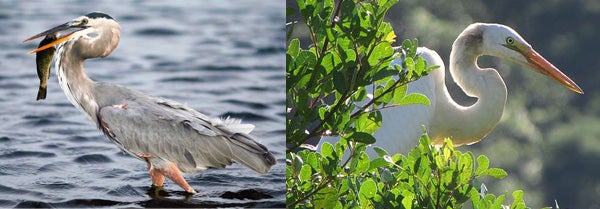
Ah, the good ol' "How many species do you see here?" debate. herodias-type heron at left, occidentalis-type heron at right. Credit: Left: Terry Foote Wikimedia(CC BY 2.0), Right: Allan Sobral Wikimedia (CC BY-SA 4.0)
Ernst Mayr wrote of his suspicion – on first learning of the ‘Great white heron’ – that it was “nothing but a locally distributed color phase of the Great blue heron” (Mayr 1956, p. 71). He noted how museum-based ornithologists of the time (the late 1950s) were inclined to regard the ‘Great white heron’ as a mere colour phase of the Great blue heron, it being field naturalists who continued to regard the two as distinct. Their arguments for distinction included the alleged shyer nature of the Great white heron (yes, really), its strong association with marine habitats, and the fact that it nests side-by-side with the Great blue heron (err…?). You don’t have to be the word’s smarterest person to realise that these arguments are not convincing.
However, Mayr (1956) showed how several features did distinguish occidentalis-type birds from herodias-type ones: the white ones aren’t just white, they also have proportionally larger bills and lack occipital plumes (or, have them in much reduced form, anyway). There’s also an unpublished project which finds data from across the skeleton showing that occidentalis-type herons can be distinguished (mostly by size) from herodias-type ones, even the very biggest Great blues that occur alongside occidentalis-type herons in Florida (Zachow 1983). Furthermore, occidentalis-type herons are associated with the Florida Keys, an observation consistent with the idea that they are a distinct population of some form, not just a randomly occurring mutation that can occur anywhere across the Great blue heron’s range.
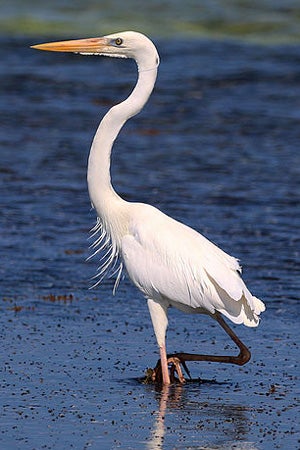
Beautiful white form of Great blue heron... or is that Great white heron? Credit: Charlesjsharp Wikimedia (CC BY-SA 4.0)
And, while there is a heron that seems like an intermediate between ‘Great white herons’ and standard Great blue ones – it’s called Würdemann’s heron and was originally considered another distinct species (A. würdemanni) – its existence is by no means inconsistent with the idea that the ‘Great white heron’ is a distinct phylogenetic entity, merely one that hybridizes with herodias-type herons wherever the ranges of the two forms overlap. Many animal populations universally considered ‘good species’ hybridise with closely related ones where they overlap (random examples: wolves and coyotes, Grevy’s zebra and Plains zebra).
Add all of this up, and the general idea has persisted that the Great white heron is at least a ‘subspecies’ of the Great blue, and something more concrete (as much as anything can be in phylogenetics and taxonomic identity) than a ‘morph’ or ‘colour form’. The idea is even out there that it should be regarded as a distinct species (McGuire 2002). I personally think that the case for taxonomic/phylogenetic distinction looks reasonably good: the Great white heron is, after all, a distinct phylogenetic entity, and this should be marked in some way. Distinct species? Well, maybe not… But a distinct subset of the entity we call Ardea herodias? Well, maybe.
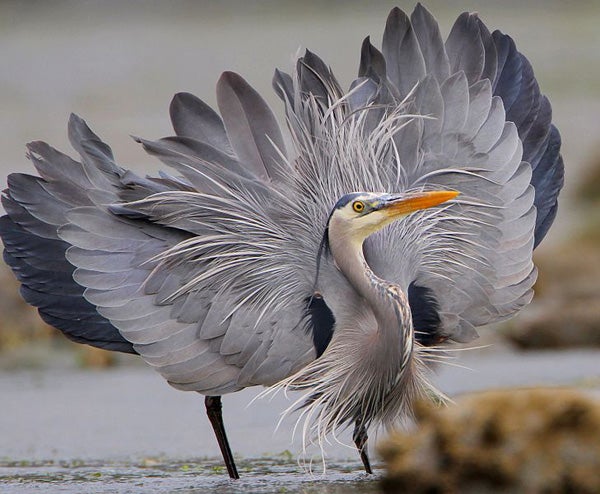
Well, there's something you don't see everyday. A Great blue heron displaying, in Vancouver. Credit: nigel Flickr (CC BY 2.0)
Where to live and what to eat. Herons are mostly associated with freshwater wetlands, and the Great blue heron typically haunts marshes, swamps, and river and lake edges. However, a key aspect of heron success is flexibility and the species also frequents mangroves, tidal mudflats and beaches. In some places – most notably the coasts of Mexico and Florida – it readily hunts in the surf and even does daredevil things like use floating kelp as a foraging platform.
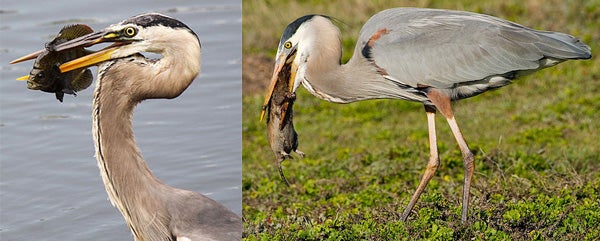
We tend to think of herons - even big ones like the Great blue heron - as dedicated fish predators. They mostly are, but they also catch and eat everything else. At left: a good shot of a speared sunfish. Right: about to swallow a rodent. Credit: Left: 350z33 English Wikipedia(CC BY-SA 3.0), Right: Rylee Isitt Flickr (CC BY-SA 2.0)
The typical style of predation used by herons is pretty well known: they stand still in shallow water, wait for fish to come within range, and then throw the head and neck forward such that they impale prey with the spear-like jaws. This action is known simply as a ‘bill stab’. The Great blue heron hunts this way, and the bulk of its diet (as much as 98% in some studies) and time spent hunting involve this ‘conventional’ fishing style. Its large size means that it consistently captures fish larger than those caught by other heron species (Willard 1977), a classic example of niche partitioning in places where the Great blue heron lives alongside smaller species. It often hunts at night in some places.
It also does several other things that most other herons typically do not, including hovering before dropping (feet-first) to pick prey off the surface of the water, and swimming in deep water (yes, herons can swim). Great blue herons have also been observed to pick up dead fish from the surface of very deep water while flapping, dangling the legs and stretching the neck forwards, the implication being that strong winds were able to help them stay aloft while in this position (Reese 1973). The Great blue heron will also flycatch – that is, grab flying prey right out of the air. On that note, there are various records of herons – mostly involving the Grey heron A. cinerea – where the birds were seen grabbing flying starlings and even hirundines (Berthold 2004).
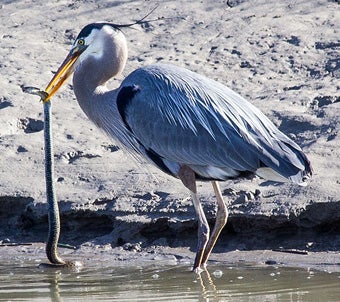
More herons with tetrapod prey. Great blue heron vs snake. Heron wins. Credit: UFSWS Mountain-Prairie Flickr (CC BY 2.0)
The Great blue heron’s diet isn’t limited to fish though, and nor are herons in general. Insects, amphibians, reptiles, mammals and birds of many species are recorded dietary items of the Great blue heron and the species often hunts in terrestrial environments, sometimes predating extensively on rodents. Individuals on the Florida Keys and Galapagos islands “frequent human habitation for scraps of food provided for them” (Hancock & Kushlan 1984). Indeed, while we think of herons as aquatic foragers, they can very easily switch to land-based hunting and frequently do so. Furthermore, members of the group could easily make the evolutionary transition to full terrestriality if conditions favoured it.
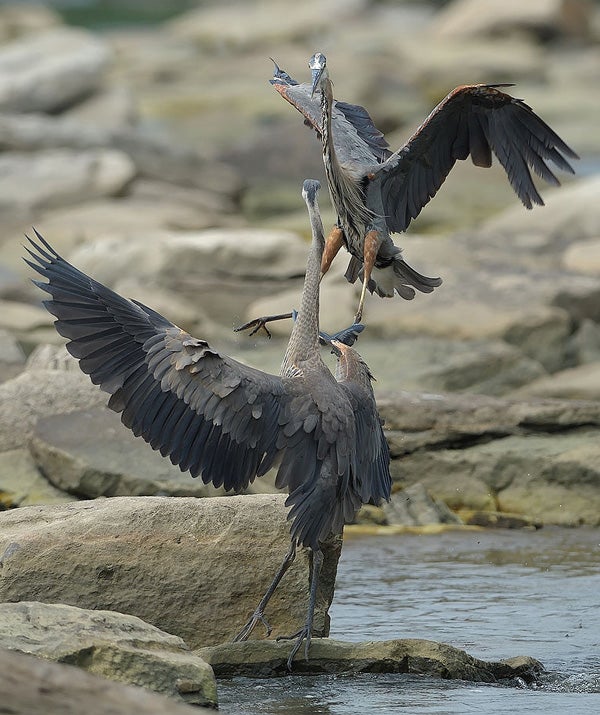
Very cool photo of two Great blue herons fighting, or playing, or play-fighting... Credit: Bert de Tilly Wikimedia (CC BY-SA 3.0)
Large prey, very large prey, and the unfortunate consequences. Among the more surprising prey items eaten by Great blue herons are rails and stilts (Olsen & Johnson 1971). Rivers & Kuehn (2006) described a case in which a Great blue heron attacked and killed a swimming Eared grebe Podiceps californicus (I’ll just leave the terms ‘Black-necked’ and ‘P. nigricollis’ here and leave you to sort it out for yourself. Yes, I’m using ‘post-split’ terminology). However, after attempting to swallow the dead grebe (which weighed 255 g), the heron eventually gave up. Rivers & Kuehn (2006) reported another observation in which an Eared grebe caught by a Great blue heron eventually escaped, apparently unharmed.
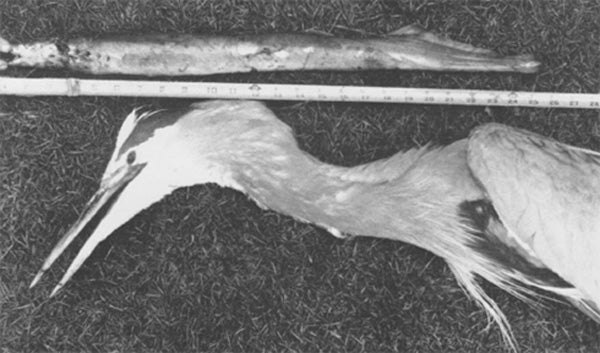
Swallowing giant lampreys can be damaging to your health. Credit: Wolf & Jones 1989
On the subject of large prey items, Great blue herons sometimes overestimate their abilities to tackle and swallow prey and can choke and die as a result. Long-time readers will recall my article from 2009 on the individuals who choked to death after attempting to swallow large Pacific lampreys Entosphenus tridentatus (Wolf & Jones 1989). Other cases of choking have involved carp, bullheads, frogs and snakes (see citations in Wolf & Jones 1989). On the subject of Great blue herons vs other birds, I should also mention the case in which a Californian Great blue heron was seen to attack and kill an American coot Fulica americana, apparently with no intent to eat it (Rivers & Kuehn 2006).
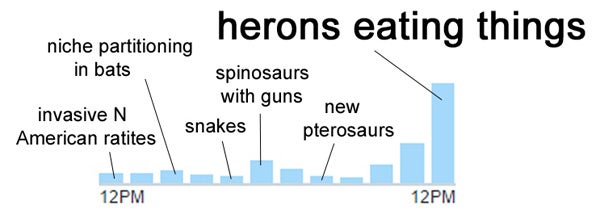
Incidentally, activity on my twitter feed shows that 'photos of herons eating things' is a subject that invites substantial public interest. Credit: Darren Naish
As always, there’s much more that could be said. I haven’t even mentioned the breeding and nesting behaviour of this bird, their display behaviour and ritual postures, nor the ‘subspecies’ that have been recognised in addition to occidentalis. But I think that will do for now. I must write about herons in general sometime soon – such a fascinating bunch.
For previous Tet Zoo articles relevant to some of the material covered here, see...
Refs - -
Berthold, P. 2004. Aerial “flycatching”: non-predatory birds can catch small birds in flight. Journal of Ornithology 145, 271-272.
Hancock, J. & Kushlan, J. 1984. The Herons Handbook. Croom Helm, London and Sydney.
Mayr, E. 1956. Is the Great white heron a good species? The Auk 73, 71-77.
McGuire, H. L. 2002. Taxonomic status of the great white heron (Ardea herodias occidentalis): an analysis of behavioral, genetic, and morphometric evidence. Final Report. Florida Fish and Wildlife Conservation Commission, Tallahassee.
Reese, J. G. 1973. Unusual feeding behaviour of great blue herons and common egrets. The Condor 75, 352.
Rivers, J. W. & Kuehn, M. J. 2006. Predation of Eared grebe by Great blue heron. The Wilson Journal of Ornithology 118, 112-113.
Sheldon, F. H., Jones, C. E. & McCracken, K. G. 2000. Relative patterns and rates of evolution in heron nuclear and mitochondrial DNA. Molecular and Biological Evolution 17, 437-450.
Zachow, K. F. 1983. The great blue and great white heron (Aves: Ciconiiformes: Ardeidae): a multivariate morphometric analysis of skeletons. Unpublished thesis, University of Miami, Florida.